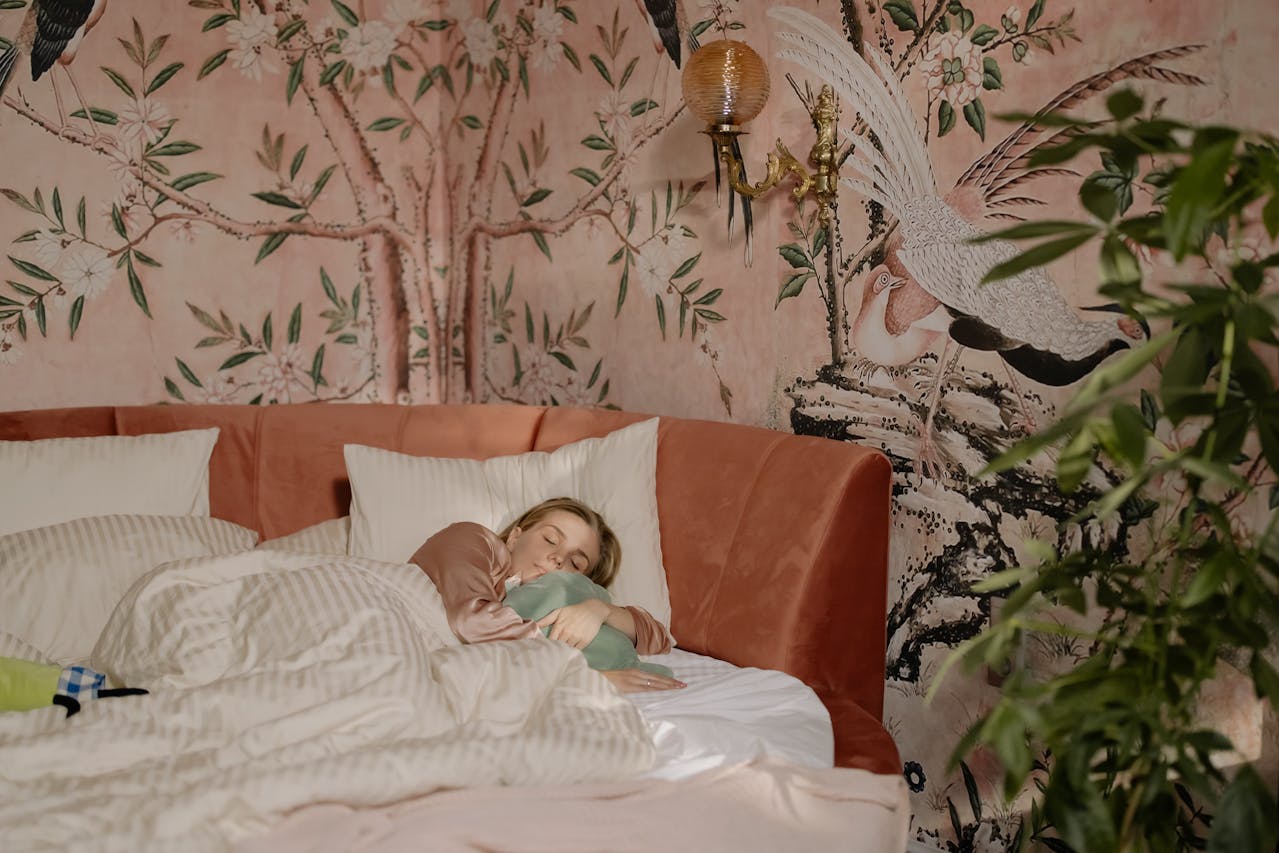When you browse tips for better sleep, you'll most likely come across suggestions to make your sleep environment as conducive as possible. And no, this idea isn't just a bait for a bedroom makeover (although this might be what you need). According to SleepFoundation.org, certain elements in your bedroom impact sleep quality.
So, how can you ensure your bedroom is comfortable enough for a decent night's sleep? We have eight tips that might help.
1. Choose Wall Colors Wisely
Colors are powerful enough to set the mood in any space, so for your bedroom, go for colors that help you relax. The general idea for choosing bedroom colors is to have a color palette that isn't too bold and vibrant.
Lighter shades of blue and green are popular choices for bedrooms because they naturally bring calmness and serenity. Other classic choices include neutral colors such as light grey, taupe, and beige, as well as pastel versions of the basic colors. Earthy bedroom colors – natural wood, terracotta statement walls, and woven baskets – are also trendy these days.
However, some people also respond well to having dark colors in the bedroom, such as navy blue, forest green, and charcoal gray. They help create a cozy and dramatic vibe, which might just be what you need to improve your bedroom environment. Still, balance is key. For example, go for white or cream bed sheets and curtains, and natural wood flooring and furniture to neutralize the dark walls.
2. Play with Light and Darkness
The right lighting relaxes you into sleep. Our bodies are incredibly attuned to light—awake during daylight and asleep at night—and it plays a significant role in regulating our natural sleep-wake cycle, better known as the circadian rhythm. Anything that disrupts this flow affects our sleep. For example, relentless blue light exposure from our phone screen at the same time as our brains try to wind down for sleeping.
In your bedroom, consider having layered lighting: bright overhead lights and warm accent lights from lamps and strip lights. This way, you can switch to softer lighting as the night sets in. If you work late or happen to be on night shift, go for blackout curtains to ensure sunlight doesn't go through the windows as you sleep.
It may also help to work on your sleep hygiene. Among the basic things you can start doing is maintaining a sleep schedule and cutting back on using electronic devices about an hour before bedtime.
3. Create Zones in Your Space

Photo by Max Vakhtbovycn from Pexels
The bedroom is ideally a separate space that is solely meant for rest. But people have different living situations—some live in studio apartments, and others have to make their bedrooms multifunctional for various reasons.
Creating zones in your space allows you to establish a natural flow. There is a nook for working, a separate area for entertainment, and so on. Making a zone just for sleep helps build psychological parameters and encourages your brain to recognize that a particular area is mainly meant for rest… and this might help you sleep better.
You can establish zones by strategically using rugs, furniture, and lighting to create some sense of separation, creatively, without having to build walls. You can also use wooden folding screens, shelves, and curtains to further mark the separation.
4. White Noise Might Help
What is white noise? According to Harvard Health Publishing, white noise "refers to noise that contains all frequencies of the sounds that people can hear, in equal parts." Think of it like the gentle hum of a fan, the whoosh of air, or radio static.
It works by masking sudden changes in your environment that might disturb you while sleeping, such as cars in traffic, dogs barking, and voices from the other room. Because your brain is less likely to notice and react to these disruptions, white noise can help you fall asleep faster and stay asleep for longer.
White noise machines are widely available. You can also play white noise tracks on your phone and set them on loop through the night.
5. Keep It Cool
Experts recommend keeping your bedroom cool. Note, cool, not cold, somewhere around 65 to 68°F. This range supports your body's natural temperature drop as you fall asleep.
Beyond adjusting your thermostat, consider using breathable bedding made of cotton and wearing light, comfortable sleepwear to help regulate your body temperature through the night.
6. Sleep Organic
“Organic” is the trend these days, and for good reason—it simply is the healthier way to go, even for your sleep.
Organic Mattress
The common mattress is predominantly produced with high chemical content and often treated with fire retardants to make it fire-safe. Ironically, the chemicals used to help ensure its safety are potentially toxic. They are linked to many health issues like respiratory irritation, hormone disruption, and, unfortunately, cancer. Moreover, these chemicals are also harmful to the environment.
An organic mattress, on the other hand, is made with non-toxic materials such as organic latex, cotton, and wool, among others. It's the healthier choice because it helps you avoid exposure to toxic chemicals. Plus, an organic mattress provides you with more comfort, it doesn't get too warm or too cold, and it's hypoallergenic. All of these qualities contribute to better sleep.
Non-toxic Furniture
If you're going for an organic mattress, you might as well pair it with a non-toxic, solid wood bed frame. Like the organic mattress, it is free from chemicals that may give off a sharp, distinctive smell that triggers headaches and allergies.
This type of bed frame is also more durable and can provide you with stable support as you sleep.
T.Y. Fine Furniture offers a variety of Naturepedic organic mattresses, which you can easily pair with our organic bed frames. Aside from bed frames, we also have dressers, side tables, and armchairs—pieces of furniture to complete the whole look of your bedroom.
7. Go for a Minimalist Bedroom

Photo by Taryn Elliott from Pexels
A minimalist bedroom might help you get better sleep. With fewer things in your space, you get fewer distractions, which somehow helps you to minimize stress.
Focus on the essentials only, the stuff that you truly need to get a good night's sleep, and bring them into your space. We're not saying to keep your bedroom devoid of any visual design and personality. But prioritize functionality first, then incorporate a touch of character through meaningful design pieces…without going overboard.
One simple way to achieve that minimalist, chill bedroom vibe is to have a few potted plants. They breathe life into a space, and they're not too distracting. Solid wood furniture with a natural finish also helps you get that rustic-chic, Scandinavian-inspired minimalist look: refreshing, warm, but oh so simple.
8. Clear the Clutter
It is easier to drift off to sleep in a clean and organized bedroom. If you see dirty clothes on the floor or the armchair, fresh laundry waiting to be folded, messy cables from your charger, a pile of books on your side table…all these things may register as tasks that need to be completed.
You may consciously or subconsciously think about the clutter you need to clear away, and if you don't do it, you feel guilty. And, this is not at all healthy for your sleep.
We previously recommended going for minimalism in the bedroom—this is one of the reasons why. Fewer things mean less clutter. But of course, for the things that you do bring into your sleeping space, you still need to keep them organized. So, make sure you have enough storage in your bedroom to help keep the space clutter-free. Go for a nice armoire or dresser and a couple of woven baskets.
We hope you find these tips helpful! For more articles like this, see also:
- How to Make Your Mattress Last Longer
- Twin, Full, Queen, or King? What Mattress Size Is Best for You?
- How a Good Mattress Impacts Sleep
Featured Photo by cottonbro studio from Pexels



Leave a comment
This site is protected by hCaptcha and the hCaptcha Privacy Policy and Terms of Service apply.